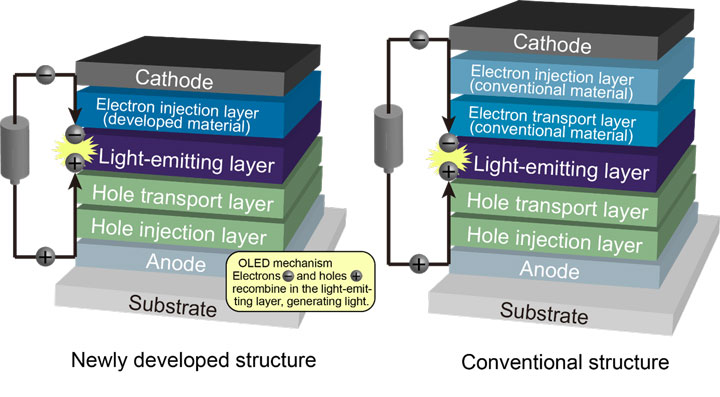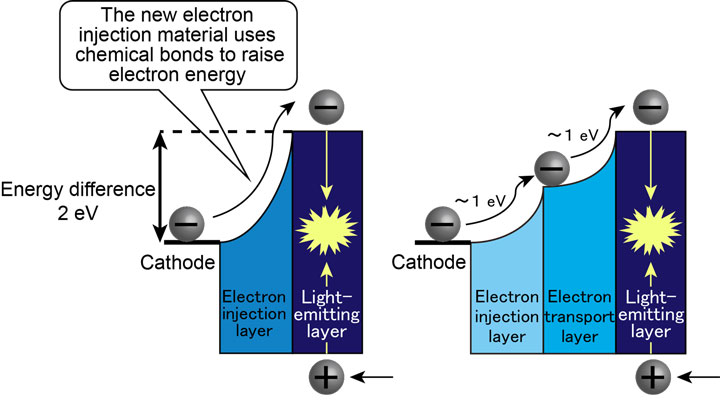

NHK:“曲がる”有機ELディスプレイ:新材料開発(動画):
NHK: “Bending” organic EL display: New material development:
NHK:“弯曲”有机EL显示器:新材料开发
NHK放送技術研究所:
「巻き取りや折り曲げができる、大画面フレキシブルディスプレイの実現」を目指しています。
NHKと日本触媒:
世界で初めて有機ELディスプレイで、電子注入動作機構を解明しました。
5月12日、
- NHK放送技術研究所は、日本触媒と共同で、
- 高性能な新規電子注入材料を共同開発した。
有機ELの性質:
有機ELでは、
- 発光層に電子を注入するため、
- 有機ELの陰極と発光層の間で、
- 2eVのエネルギー差を、ゼロにする必要がある。
電子注入材料を新開発:
ーエネルギー差ゼロを実現ー
- 新開発の電子注入材料により、
- 陰極や有機材料との化学結合を利用して、
- エネルギー差をゼロにすることに成功した。
新しい発見:
さらに、
「従来の有機EL・電子輸送材料」は、電子を輸送する役割よりも、
むしろ、「エネルギー差を約1eV減らす役割が大きいこと」も解明した。
電子輸送材料が不要:
これらの発見で、「新規電子注入材料を用いれば、電子輸送材料が不要」となる。
その結果、発光層に直接電子を注入できる。
(Impress Watch) – Yahoo!ニュース
https://news.yahoo.co.jp/articles/2fde5abd22c1cc7428e02c94a69d091b6a6ec15e
OLED Electron Injection Mechanism Explained
NHK Science & Technology Research Laboratories (NHK STRL)
is conducting R&D on organic light-emitting-diode (OLED)1) devices, with the goal of realizing flexible, large-screen displays that can be folded or rolled up.
To extend the lifetime of flexible displays and reduce power consumption,
NHK STRL has developed an electron injection layer (EIL) material, which injects electrons from the cathode into the light emitting layer2).
At this time, we give the first-ever explanation of the electron injection mechanism and have developed a new EIL material that will further improve performance*.
To inject electrons into the light-emitting layer in an OLED device,
the energy difference of approximately 2 eV between the cathode and the light-emitting layer must be reduced to zero.
We have explained, for the first time,
how the EIL material we have developed uses its chemical bonds with the neighboring material reduce this difference to zero.
We have also explained how the electron transport material used in conventional OLED devices
reduces this energy difference by approximately 1 eV, which is an even more important role than transporting the electrons.
These discoveries have shown that with the new EIL material, the electron transport material is no longer needed, and it can inject electrons directly into the light-emitting layer.
The new EIL material will contribute to extending the lifetime and reducing power consumption of OLED devices
and also simplify the structure of OLED devices, since the electron transport material is no longer needed.
These research results were published in the May 11 edition of Nature Communications.
We are continuing R&D to create flexible displays with longer lifetime and lower power consumption as soon as possible.
NHK STRL